INTRODUCTION
MATERIALS AND METHODS
Study Population
Cardiovascular Magnetic Resonance
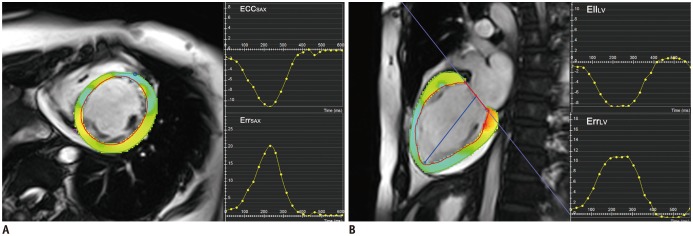 | Fig. 1Myocardial strain measurement by feature tracking method in 43-year-old female patient with acute myocarditis.After endocardial and epicardial borders of LV were traced semi-automatically, software (CVI42) automatically tracked endocardial and epicardial borders across frames during cardiac cycle. EccSAX and ErrSAX measurements (A) were obtained using mid-ventricular level short-axis cine views. EllLV and ErrLax measurements (B) were obtained from 2-chamber long-axis view. EccSAX = LV circumferential strain measured from short-axis cine views, EllLV = LV longitudinal strain measured from long-axis cine views, ErrLax = LV radial strain measured from long-axis cine views, ErrSAX = LV radial strain measured from short-axis cine views, LV = left ventricular
|
Clinical Outcomes
Statistical Analysis
RESULTS
Study Population
Table 1
Baseline Characteristics of Patients
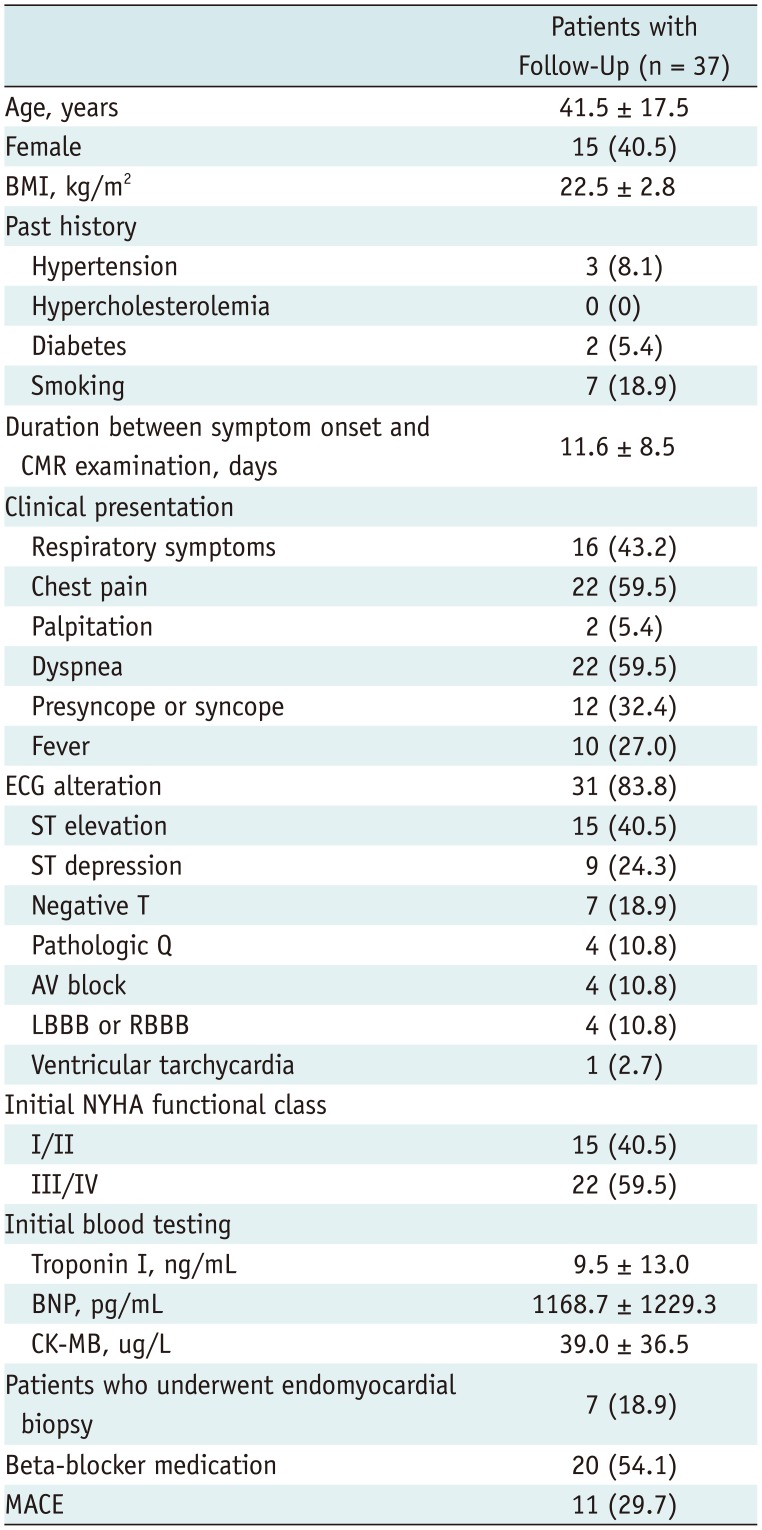
Data are provided as n (%) or mean ± SD. AV = atrioventricular, BMI = body mass index, BNP = brain natriuretic peptide, CK-MB = creatine kinase MB, CMR = cardiovascular magnetic resonance, ECG = electrocardiography, LBBB = left bundle branch block, MACE = major adverse cardiovascular events, NYHA = New York Heart Association, RBBB = right bundle branch block
CMR Findings
Table 2
CMR Findings of Patients with Acute Myocarditis and Normal Subjects
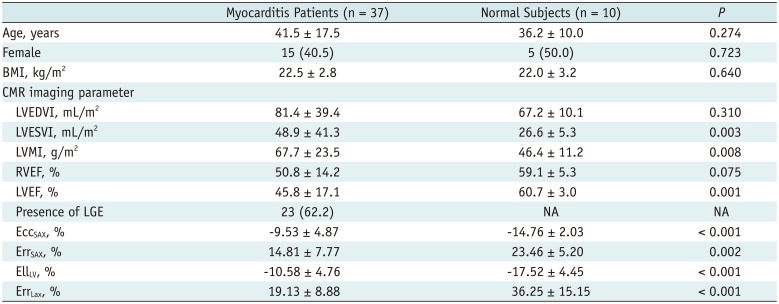
Values are n (%) or means ± SD. BMI = body mass index, CMR = cardiovascular magnetic resonance, EccSAX = LV circumferential strain measured from short-axis cine views, EllLV = LV longitudinal strain measured from long-axis cine views, ErrLax = LV radial strain measured from long-axis cine views, ErrSAX = LV radial strain measured from short-axis cine views, LGE = late gadolinium enhancement, LV = left ventricle, LVEDVI = left ventricular end-diastolic volume index, LVEF = left ventricular ejection fraction, LVESVI = left ventricular end-systolic volume index, LVMI = left ventricular mass index, NA = not applicable, RVEF = right ventricular ejection fraction
Table 3
Comparison of Myocardial Stain Parameters between Myocarditis Patients without and with Preserved EF and Normal Subjects

Values are n (%) or means ± SD. *Significantly different between myocarditis patients with preserved EF and normal subjects, †Significantly different between myocarditis patients with impaired EF and normal subjects. BMI = body mass index, EccSAX = LV circumferential strain measured from short-axis cine views, EF = ejection fraction, EllLV = LV longitudinal strain measured from long-axis cine views, ErrLax = LV radial strain measured from long-axis cine views, ErrSAX = LV radial strain measured from short-axis cine views, LV = left ventricle
Table 4
Intra-Observer and Inter-Observer Reproducibility According to Intra-Class Correlation for Strain Quantification on CMR

CI = confidence interval, CMR = cardiovascular magnetic resonance, EccSAX = LV circumferential strain measured from short-axis cine views, EllLV = LV longitudinal strain measured from long-axis cine views, ErrLax = LV radial strain measured from long-axis cine views, ErrSAX = LV radial strain measured from short-axis cine views, ICC = intra-class correlation coefficient, LV = left ventricle
Clinical Outcomes: MACE
Table 5
Univariate Cox Regression Analysis: MACE
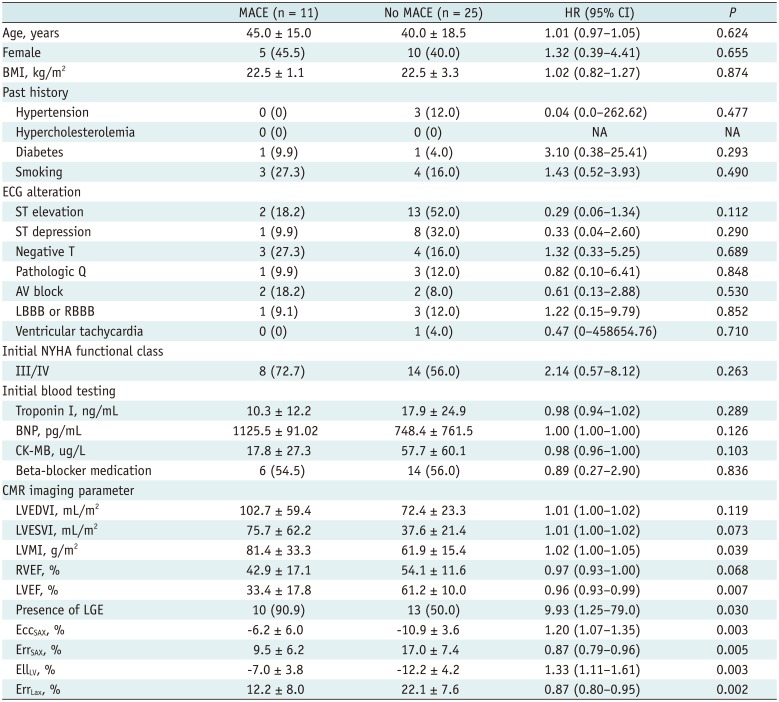
Values are n (%) or mean ± SD. AV = atrioventricular, BMI = body mass index, BNP = brain natriuretic peptide, CI = confidence interval, CK-MB = creatine kinase MB, CMR = cardiovascular magnetic resonance, EccSAX = LV circumferential strain measured from short-axis cine views, ECG = electrocardiography, EllLV = LV longitudinal strain measured from long-axis cine views, ErrLax = LV radial strain measured from long-axis cine views, ErrSAX = LV radial strain measured from short-axis cine views, HR = hazard ratio, LBBB = left bundle branch block, LGE = late gadolinium enhancement, LV = left ventricle, LVEDVI = LV end-diastolic volume index, LVEF = LV ejection fraction, LVESVI = LV end-systolic volume index, LVMI = LV mass index, MACE = major adverse cardiovascular events, NA = not applicable, NYHA = New York Heart Association, RBBB = right bundle branch block, RVEF = right ventricular ejection fraction
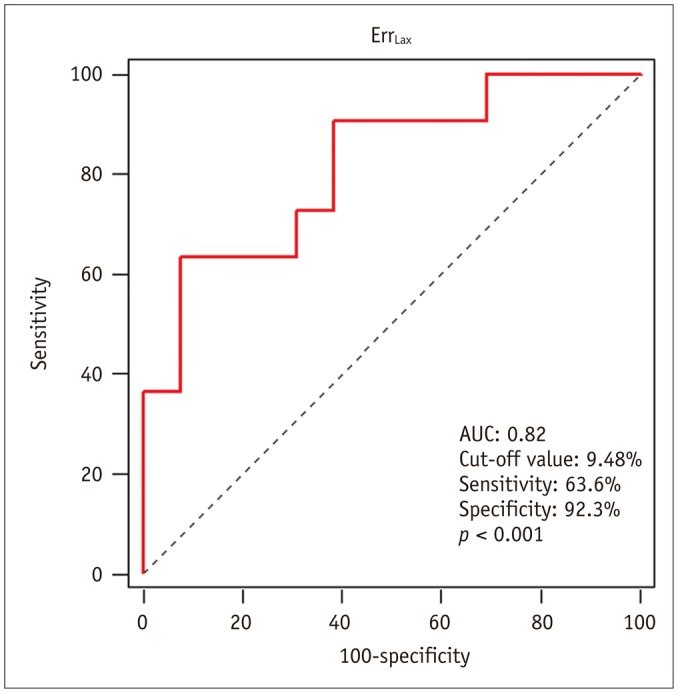 | Fig. 2Receiver operating characteristic curve for prediction of MACE.MACE was defined in terms of cardiac death, heart transplantation, implantable cardioverter defibrillator or pacemaker, rehospitalization following cardiac event, or embolic stroke. AUC = area under the curve, ErrLax = LV radial strain measured from long-axis cine views, LV = left ventricle, MACE = major adverse cardiovascular events
|
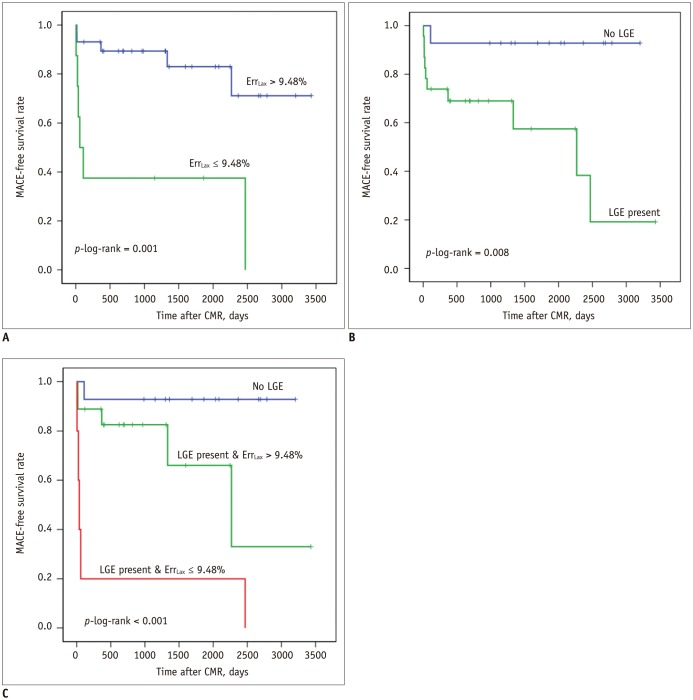 | Fig. 3MACE according to ErrLax or presence of LGE.
A. Survivial in patients with ErrLax ≤ 9.48% vs. those with ErrLax > 9.48%. Note that only one patient without LGE experienced MACE dring follow-up. B. Survivial in patients with LGE vs. those without LGE. C. Survivial in patients with ErrLax ≤ 9.48% and presence of LGE vs. those with ErrLax ≤ 9.48% and presence of LGE vs. those without LGE. Patients with LGE and decreased ErrLax (≤ 9.48%) had worse outcome, compared to patients with LGE only. CMR = cardiovascular magnetic resonance, ErrLax = LV radial strain measured from long-axis cine views, LGE = late gadolinium enhancement, LV = left ventricle, MACE = major adverse cardiovascular events
|
Clinical Outcomes: Functional Improvement
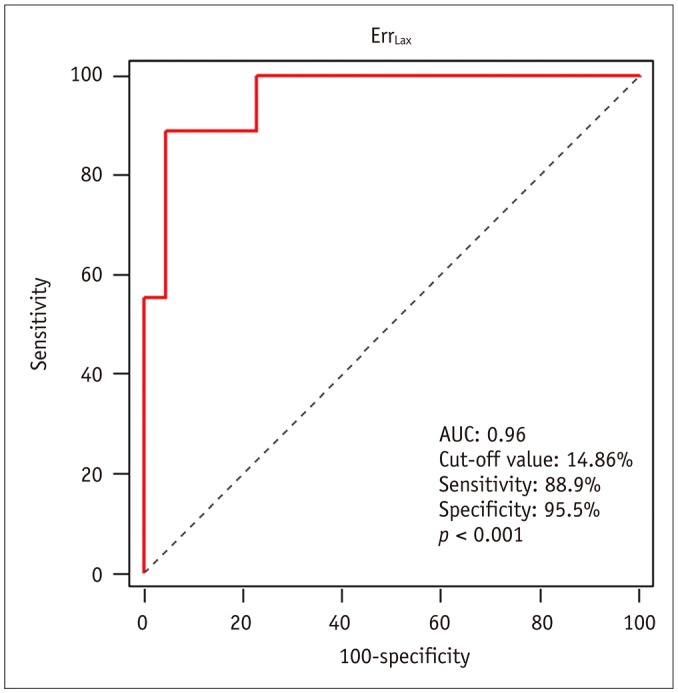 | Fig. 4Receiver operating characteristic curve for prediction of incomplete left ventricular functional recovery.AUC = area under the curve, ErrLax = LV radial strain measured from long-axis cine views, LV = left ventricle
|
Table 6
Univariate Analysis: Incomplete Left Ventricular Functional Recovery
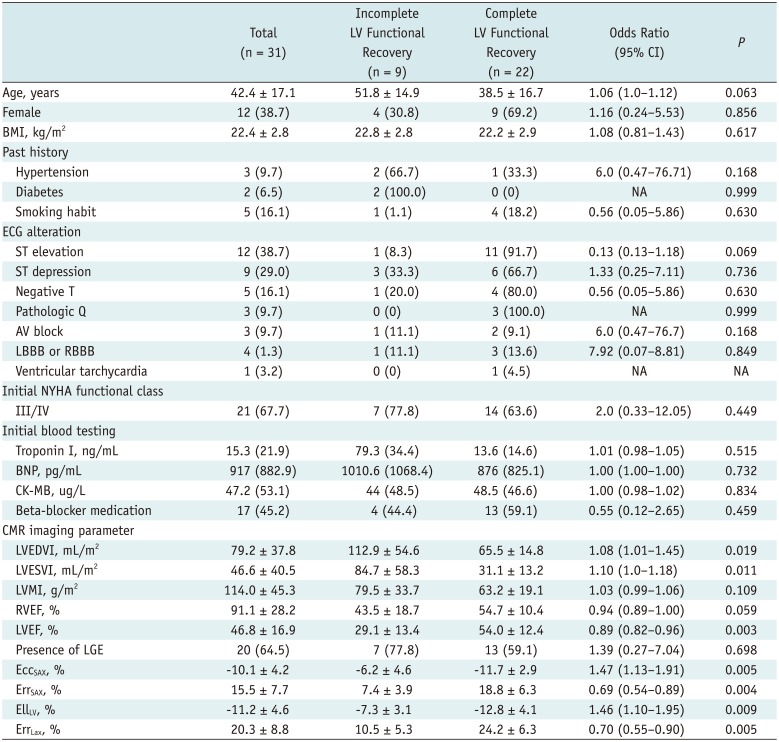
Values are n (%) or means ± SD. AV = atrioventricular, BMI = body mass index, BNP = brain natriuretic peptide, CK-MB = creatine kinase MB, CMR = cardiovascular magnetic resonance, EccSAX = LV circumferential strain measured from short-axis cine views, ECG = electrocardiography, EllLV = LV longitudinal strain measured from long-axis cine views, ErrLax = LV radial strain measured from long-axis cine views, ErrSAX = LV radial strain measured from short-axis cine views, LBBB = left bundle branch block, LGE = late gadolinium enhancement, LV = left ventricle, LVEDVI = LV end-diastolic volume index, LVEF = LV ejection fraction, LVESVI = LV end-systolic volume index, LVMI = LV mass index, MACE = major adverse cardiovascular events, NA = not applicable, NYHA = New York Heart Association, RBBB = right bundle branch block, RVEF = right ventricular ejection fraction




 PDF
PDF ePub
ePub Citation
Citation Print
Print


 XML Download
XML Download